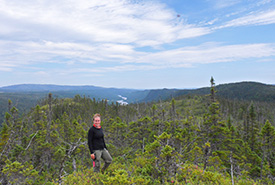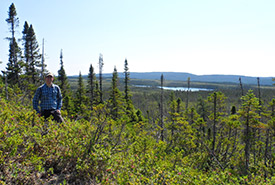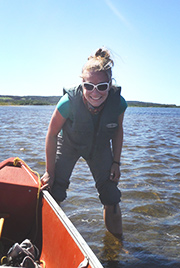Exploring Lloyd's River

A view of Lloyd’s River from atop the escarpment (photo by NCC)
When I woke up early on the morning of July 8 in my apartment in St. John’s, it was hard to believe that I’d be in the deep woods of Central Newfoundland that night.
Weeks of planning and preparation had been leading up to this day, so I was both relieved and excited that it was finally here! Eight and a half hours away, on the southeastern slopes where Lloyd’s River flows into Red Indian Lake, the Nature Conservancy of Canada’s (NCC’s) nature reserve awaited; my home for the next seven days.
The Lloyd’s River property, spanning over 2,000 acres (800 hectares), was secured in 2004 in partnership with Abitibi-Consolidated and contains a diverse landscape of mature balsam fir and back spruce forest, open peatlands and stark barrens.
This area provides core habitat for the Newfoundland marten as well as Canada lynx, whose population is on the decline. Coyote, red fox, ermine, osprey and boreal owl are a few other species that inhabit the area.
Due to the remote location, it had not been visited in several years, so conservation intern Brandon Ward and I were off to trek in to monitor the property; a task both intimidating and exciting!
By nine o’clock that evening we had arrived with the help of a local outfitter, crossed the river, chosen our site and were starting to set up camp. The flies were an eager welcome committee. In the brief time that we had before the sun set, we were in awe of the natural beauty around us and looked forward to exploring it further.
The following days were filled with challenges and triumphs as we investigated this relatively untouched wilderness.
On the first day of monitoring, we oriented ourselves on the property and were impressed by the species diversity that we observed, including alternate-leaf dogwood and yellow birch, both provincially rare species.

NCC intern Brandon Ward looking out over the peatland (Photo by NCC)
On the second day we tackled the escarpment and climbed to the barren top of the ridge to look over the forested slopes below. It was a tough climb, but worth it for the view and the feeling that we had really earned it!
The next day we investigated the forest, finding an abundance of old-growth black spruce and balsam fir.
By day four we were ready to climb again; this time exploring the back side of the slopes where we found caribou trails traversing the open bogs and highland barrens. On our last monitoring day we trekked through the forest again, this time discovering white pine in the composition, bringing the “pine-clad hills,” mentioned in Sir Cavendish Boyle's "Ode to Newfoundland" to life.
The weather for our entire trip was sunny and warm, and at the end of every day we could not wait to go swimming in the river! While relaxing in the cool water it was satisfying to look up at the slopes that we had conquered.
In the evenings, we would reflect on the day’s work, plan for the remainder of our monitoring and enjoy our surroundings until the bugs drove us into the tent, which is when the playing cards came out.
On the last morning, we woke early and packed up our belongings to kayak out along Lloyd’s River, soaking in our final glances of the breathtaking landscape. A calm paddle down the river as the sun broke through the clouds was the perfect way to end our trip.
We left no trace of our visit behind, but the memories of our adventure are ones that I will not soon forget.


